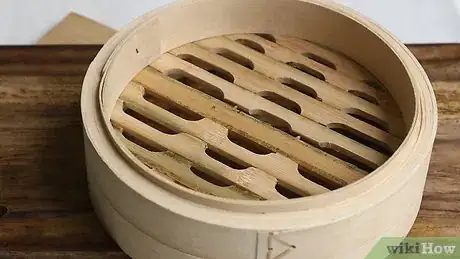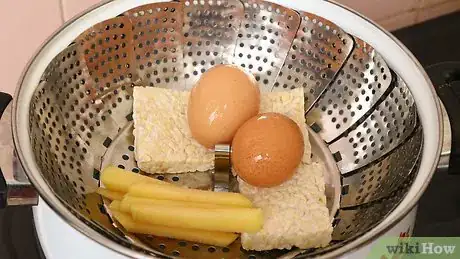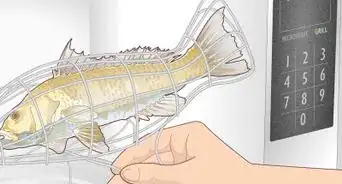This article was co-authored by wikiHow Staff. Our trained team of editors and researchers validate articles for accuracy and comprehensiveness. wikiHow's Content Management Team carefully monitors the work from our editorial staff to ensure that each article is backed by trusted research and meets our high quality standards.
The wikiHow Video Team also followed the article's instructions and verified that they work.
This article has been viewed 55,844 times.
Learn more...
Steaming is a healthy way to cook anything from vegetables to fish to dumplings. To steam food at home, you’ll need a basket steamer. You can use a bamboo basket steamer if you have a wok or a shallow pan, or you can use a metal basket steamer, which looks like a colander and sits inside a deeper saucepan. Both methods are quick and simple, and a perfect way to make tonight’s dinner!
Steps
Cooking with a Bamboo Basket Steamer
-
1Choose a basket steamer based on how much food you want to cook at once. Bamboo basket steamers come in all different sizes and number of tiers. Pick one according to the quantity of food you usually cook and whether you want to steam multiple types of food at once. For example, the more tiers your steamer has, the more variety of food you can cook at one time.[1]
- If you’re a home cook, opt for the standard 10 to 12 in (25 to 30 cm) basket steamer. If you’re buying a steamer for a restaurant or commercial use, go with a larger one, like one that’s 30 inches (76 cm).
- You can buy a bamboo basket steamer from a kitchen store or an online retailer.
-
2Line the bottom of each tray with a lettuce leaf. Take a large, clean lettuce leaf and lay it over the bottom of each tier that you’re going to use. This prevents the food from sticking to the basket steamer.[2]
Tip: Instead of lettuce, you can also use cabbage leaves or parchment steamer liners.
Advertisement -
3Place the food you want to steam on top of the lettuce. Spread out the food in a single layer over the lettuce leaf. To avoid overcrowding the steamer and to help the food cook evenly, leave a little space between the food instead of packing it tightly together.[3]
- If you’re steaming meat and veggies, put the meat on a separate tier since it takes longer to cook.
Tip: You can steam all different types of food, like vegetables, fish, shrimp, beef, chicken, and dumplings.
-
4Add water to a shallow pan that's big enough to hold the steamer basket. Choose a pan that your steamer basket fits snugly inside and is around 2 to 3 inches (5.1 to 7.6 cm) deep. Check that the basket won't tip over or move around too much. Then pour about 1 to 2 in (2.5 to 5.1 cm) of water into the bottom.[4]
- You can also use a wok, which is the traditional pan of choice in Asian cooking.
- To prevent the bottom of your basket from burning, pick a pan that has sloped sides. This keeps the basket slightly raised off the bottom of the pan.
-
5Bring the water to a simmer. Place the pan on the stove and turn it to medium heat. Wait until the water is gently bubbling or just before it starts to boil.[5]
- On a 9-setting stove, for instance, medium heat is any setting between 4 and 6.
-
6Place the steamer in the pan and put the lid on top of the basket. Once the water reaches a simmer, set the steamer basket into the pan, making sure the bottom layer of the basket isn’t completely submerged. Cover the top of the steamer basket with the lid.[6]
- If the bottom layer of food is underwater, pour out some of the water before placing the basket into the pan.
-
7Let your food steam until it's cooked to your liking. How long you steam the food depends on the type that you’re cooking. Let vegetables cook for about 5 to 7 minutes, fish or dumplings cook for 10 to 15 minutes, and meat, like chicken, cook for closer to 25 to 30 minutes.
- Choose your steaming time based on the texture and temperature you prefer your food, too. For example, if you like softer veggies, steam them longer than if you like crunchier ones.
- Use a meat thermometer to measure when meat is done cooking. For instance, cook chicken until it's at least 165 °F (74 °C).
- Check the water level every so often as the food cooks. If you notice it’s getting low, add a little more. The water is what creates the steam.
Tip: If you’re steaming different types of food on different tiers, put the food that takes the longest to cook on the bottom. Then, add the other levels after a few minutes, based on their cooking times.
Using a Metal Basket Steamer
-
1Bring 1 to 2 inches (2.5 to 5.1 cm) of water to a boil in a small saucepan. Pour water into the bottom of a saucepan that your steamer will fit inside. Place the pan on the stove and bring it to a boil over medium-high heat.[7]
- Wait until the water is vigorously bubbling, which means it’s boiling.
- On a 9-setting stove, for instance, medium-high heat is 5 to 7.
-
2Set the steamer basket into the saucepan and place the food inside. Once the water is boiling, rest the steamer basket in the saucepan, making sure that the water stays below the basket. Add the food that you want to steam to the bottom of the basket.[8]
- If the water comes up into the basket, pour some of it out before adding your food.
Tip: Cook different types of food separately. Don’t try to steam fish and veggies at the same time since they have different cooking times.
-
3Cover the saucepan with a lid and reduce the heat to medium. Place a lid on top that completely covers the pan with the steamer inside. Then, turn the heat down on the stove to medium, which is 4 to 6 on a stove with 9 settings.[9]
- Use a lid that fits snugly over the pan so that no steam or moisture escapes. Otherwise, the food won’t cook properly.
-
4Let the food steam until cooked thoroughly. Steam the food until it’s cooked to your liking. For example, most vegetables will steam in 5 to 7 minutes, whereas fish takes 10 to 15 minutes, and meat will take 25 to 30 minutes on average.[10]
- To check if vegetables are done cooking, poke them with a fork or knife to see if they’re tender and soft.
References
- ↑ https://www.bonappetit.com/test-kitchen/tools-test-kitchen/article/how-to-use-bamboo-steamer
- ↑ https://www.thekitchn.com/how-to-use-a-bamboo-steamer-ba-127621
- ↑ https://www.thekitchn.com/how-to-use-a-bamboo-steamer-ba-127621
- ↑ https://www.bonappetit.com/test-kitchen/tools-test-kitchen/article/how-to-use-bamboo-steamer
- ↑ https://www.bonappetit.com/test-kitchen/tools-test-kitchen/article/how-to-use-bamboo-steamer
- ↑ https://www.thekitchn.com/how-to-use-a-bamboo-steamer-ba-127621
- ↑ https://www.thekitchn.com/how-to-steam-vegetables-cooking-lessons-from-the-kitchn-108512
- ↑ https://www.thekitchn.com/how-to-steam-vegetables-cooking-lessons-from-the-kitchn-108512
- ↑ https://www.epicurious.com/expert-advice/how-to-steam-vegetables-step-by-step-article
About This Article
To use a bamboo basket steamer, first, line the bottom with lettuce leaves to prevent the food from sticking to the steamer. Then, place the food you want to steam on top of the lettuce, spreading it out in a single layer so it cooks evenly. When you're ready to start cooking, add water to a shallow pan that's big enough to hold your steamer basket and bring the water to a simmer. Once it's simmering, place the steamer in the pan with the lid on top. If you are cooking meat, leave it to steam for 25 to 30 minutes, unless it's fish or dumplings, which only need to steam for 10 to 15 minutes. You can also steam vegetables in as little as 5 minutes, depending on how tender you want them to be. For more tips, like how to use a metal basket steamer, read on!





























































